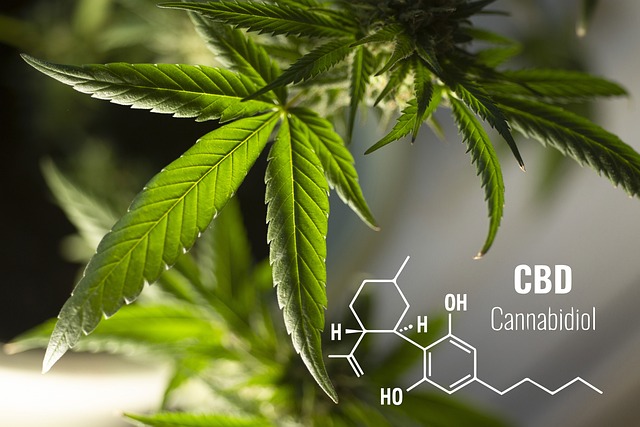High Potency Cannabinoids (HPC) have emerged as a significant area of interest in the cannabis industry due to their diverse therapeutic effects, which include alleviating symptoms of chronic pain, anorexia, and anxiety. These compounds, including THC and CBD, interact with the endocannabinoid system and can be modulated by terpenes through a phenomenon known as the entourage effect, enhancing their benefits. The therapeutic properties of HPCs are further supported by rigorous laboratory testing to ensure safety, efficacy, and uniformity in products. Ongoing research is critical to understand both the beneficial and adverse health implications of HPCs, with a focus on harnessing their potential for targeted treatments. The role of terpenes in influencing the effects and pharmacokinetics of cannabinoids is an area of growing interest. Ensuring ethical integrity in research through Institutional Review Board (IRB) approval and adherence to stringent legal regulations is essential for maintaining credibility, trust, and safety within the cannabis sector. As HPCs continue to gain popularity, the need for comprehensive testing, quality assurance, and legal compliance remains at the forefront to support their safe and effective use.
Exploring the cutting-edge developments in the realm of cannabis, this article delves into the transformative potential of high potency cannabinoids (HPCs). From their formulation to their effects on health, and the role of terpenes in amplifying their benefits, we dissect the science behind these compounds. In addition, we provide a comprehensive overview of key cannabinoids like CBC, CBG, and THCV, which go beyond the well-known THC and CBD. With a focus on lab testing and quality assurance, this piece ensures that consumers are equipped with the knowledge to navigate the complex landscape of high potency cannabis products responsibly. Moreover, we address the legal considerations surrounding HPCs to ensure users stay informed and compliant. Join us as we unlock the mysteries and explore the future of high potency cannabinoids.
Unlocking the Power of High Potency Cannabinoids: An Overview

The field of cannabinoid research has seen significant advancements with the advent of high potency cannabinoid (HPC) compounds. These powerful derivatives, found within the cannabis plant, have garnered attention due to their unique therapeutic properties and potential for various medical applications. Scientists are meticulously studying HPCs to understand their effects on human health, focusing on how they can be harnessed to alleviate symptoms of conditions such as chronic pain, inflammation, and neurological disorders. The precise nature of these compounds allows researchers to pinpoint their interactions within the body’s endocannabinoid system, leading to a deeper comprehension of cannabinoid efficacy and safety profiles. As research progresses, the application of high potency cannabinoids in pharmaceuticals and wellness products is becoming increasingly promising, with ongoing clinical trials aiming to solidify their role in modern medicine. The potential of HPCs to revolutionize treatment paradigms is immense, as they offer a targeted approach to therapeutic intervention that could be tailored to individual patient needs.
The Science Behind High Potency Cannabinoid Formulations

High potency cannabinoid formulations represent a significant advancement in the field of cannabinoid research and therapeutic applications. These formulations are meticulously engineered to deliver precise, concentrated doses of cannabinoids, which are the active compounds found in the Cannabis sativa plant. Scientists leverage advanced extraction and purification techniques to isolate and concentrate specific cannabinoids like THC (tetrahydrocannabinol) and CBD (cannabidiol), among others, to achieve a desired therapeutic effect. The precise dosing allows for a controlled and consistent experience, which is crucial for both medical and recreational use.
In the lab setting, researchers employ chromatography and other sophisticated analytical methods to ensure the purity and potency of each cannabinoid batch. These rigorous quality control measures are essential for producing safe and effective products. The science behind these formulations is rooted in a deep understanding of the endocannabinoid system within the human body, which regulates various physiological processes. By tailoring cannabinoid profiles to individual patient needs or desired effects, high potency cannabinoid formulations can be optimized for a range of conditions, from pain management to anxiety relief. This targeted approach allows users to experience the full therapeutic benefits of cannabinoids without the unnecessary plant material that could otherwise dilute their effects.
Key Cannabinoids: CBC, CBG, and THCV Beyond THC and CBD

The cannabis plant is a rich source of various compounds, with THC and CBD traditionally taking center stage in discussions about their therapeutic potential. However, recent research has brought to light the roles of other high potency cannabinoids such as CBC (cannabichromene), CBG (cannabigerol), and THCV (tetrahydrocannabivarin). These lesser-known compounds are gaining attention for their unique properties and potential benefits.
CBC, while less abundant than THC or CBD, has garnered interest due to its ability to influence pain, mood, appetite, and inflammation. Studies suggest that CBC may work synergistically with other cannabinoids to enhance their effects, offering a broader spectrum of therapeutic applications. On the other hand, CBG is celebrated for its versatile capabilities as a precursor to many other cannabinoids, including THC and CBD. Its potential applications are vast, ranging from neuroprotective and anti-inflammatory properties to promising effects in treating glaucoma.
THCV, a minor cannabinoid that deviates from the typical THC structure, presents an intriguing profile with its unique psychoactive effects. Unlike THC, THCV does not induce strong psychoactive effects but may help regulate appetite and blood sugar levels. Its neuroprotective qualities are also of significant interest to researchers exploring its potential in treating various neurological conditions. Together, these high potency cannabinoids demonstrate the complexity and depth of cannabis’s chemical makeup, offering a multitude of therapeutic avenues beyond the well-known effects of THC and CBD. As research continues, the full potential of these compounds may further illuminate their significant roles in medicine and health.
Lab Testing and Quality Assurance in High Potency Cannabis Products

In the realm of cannabis products, high potency cannabinoids have gained significant attention due to their therapeutic potential and varied effects. Lab testing plays a pivotal role in ensuring the safety, efficacy, and consistency of these products. Advanced laboratory procedures are employed to accurately measure the concentration of cannabinoids such as THC and CBD, as well as to detect any contaminants that could compromise user health. These tests include potency analysis, terpene profiling, and contamination screening for residual solvents, pesticides, and microbial impurities. Quality assurance protocols are stringently followed to maintain the integrity of the products throughout the production process. This involves rigorous testing at various stages, from raw material input to the final product. By adhering to these standards, producers can guarantee that high potency cannabinoid products meet regulatory requirements and provide a safe and reliable experience for consumers. The implementation of such comprehensive testing and quality control measures is essential for fostering consumer trust and ensuring the market’s integrity in the burgeoning cannabis industry. With an increasing demand for high-quality, high potency cannabinoid products, labs serve as the gatekeepers of safety and efficacy, ensuring that these products are not only potent but also pure and free from harmful substances.
Understanding the Effects of High Potency Cannabinoids on Health

Research into the effects of high potency cannabinoids on health has been a focal point in scientific communities, given the increasing availability and varying legal statuses of these compounds. High potency cannabinoids, particularly those like THC and CBD, have shown to exhibit both therapeutic and psychoactive properties, necessitating a thorough examination of their impact on human physiology and psychology. Studies have indicated that these cannabinoids can influence pain perception, appetite, mood, and inflammation, offering potential benefits for conditions such as chronic pain, anorexia, and anxiety. However, the same potency that may confer therapeutic advantages also raises concerns regarding their long-term effects on cognitive function and mental health. Laboratory trials have been instrumental in dissecting the complex mechanisms by which cannabinoids interact with the human endocannabinoid system. As such, ongoing research continues to shed light on both the beneficial and adverse implications of high potency cannabinoids, aiming to inform future clinical applications and policy decisions. Understanding the nuanced effects of these substances is crucial for developing safe and effective treatments while minimizing potential health risks.
The Role of Terpenes in Enhancing High Potency Cannabinoid Efficacy

Terpenes, the aromatic compounds found abundantly in cannabis and many other plants, play a significant role in enhancing the efficacy of high potency cannabinoids (HPC). These organic molecules not only contribute to the distinct flavors and aromas of cannabis but also interact with the cannabinoids in complex ways that can influence the therapeutic effects. The entourage effect, a term coined to describe this synergistic interaction between terpenes and cannabinoids, is thought to enhance the benefits of HPC products. For instance, the terpene myrcene is known for its sedative properties and is often found in high concentrations in strains with high THC content. It can potentiate the effects of THC, leading to a more profound relaxation effect. Similarly, limonene, another prevalent terpene, is associated with mood elevation and can enhance the uplifting qualities of certain cannabinoids. The precise mechanism behind these interactions is still under scientific investigation, but it is clear that the presence of terpenes can significantly affect the user’s experience and the therapeutic outcomes of HPC products.
Furthermore, the role of terpenes in modulating the effects of high potency cannabinoids extends beyond subjective experiences. Research has indicated that certain terpene profiles can influence the pharmacokinetics of cannabinoids, affecting how they are absorbed, distributed, metabolized, and excreted by the body. This suggests a potential for terpenes to tailor the efficacy and duration of action of HPCs. As the scientific community continues to explore the intricate interactions between terpenes and cannabinoids, there is growing interest in developing targeted cannabis-based treatments that leverage these natural synergies. Understanding how specific terpene compositions can enhance or mitigate the effects of HPCs will be crucial for optimizing these compounds’ therapeutic potential.
Navigating Legal Considerations for High Potency Cannabinoids

When exploring the realm of High Potency Cannabinoids (HPCs), it is imperative to navigate the complex legal landscape that governs their research, production, and application. The legal status of HPCs varies across different jurisdictions, necessitating a thorough understanding of local, state, and federal regulations. In the United States, for instance, the 2018 Farm Bill legalized hemp-derived products containing less than 0.3% THC at the federal level; however, state laws can be more stringent, imposing additional restrictions or outright bans on certain cannabinoids. Researchers must comply with Controlled Substances Act (CSA) regulations when handling Schedule I substances, which classifies THC and other cannabinoids with psychoactive properties.
To engage in the cultivation, extraction, or formulation of HPCs, entities must secure appropriate licenses and adhere to Good Manufacturing Practices (GMP). Moreover, any research involving HPCs must undergo rigorous institutional review board (IRB) approval processes to ensure ethical standards are upheld. The legal framework for HPCs is not static; it evolves as new scientific findings emerge and public policy shifts. Stakeholders in this field must stay informed about the latest regulations and ensure their operations remain compliant to avoid legal entanglements. Additionally, with the potential therapeutic benefits of HPCs come high expectations for safety and efficacy. Ensuring compliance with legal requirements is a critical step towards establishing credibility and trust in the scientific community and among consumers. It is a dynamic and evolving area that requires vigilant attention to both the spirit and the letter of the law, as well as a commitment to ethical research practices.
